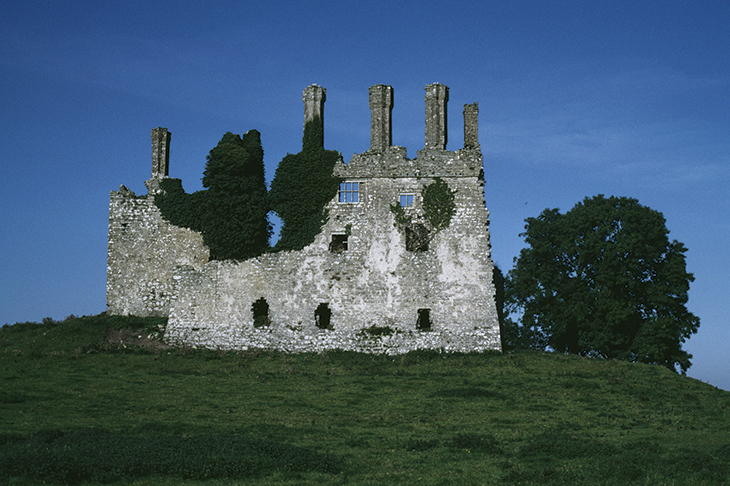The Celtic Tiger has come and gone. Over the past 30 years, billions of pounds poured into Irish houses and then drained out again. The ruins of Ireland have slumbered on through the peak, the trough and the current blessed recovery. Medieval castles, Georgian country houses, Victorian lodges… They cling on, disappearing under the ivy, slowly crumbling, in demesnes across the island of Ireland.
As Robert O’Byrne, aka the Irish Aesthete, writes in his new guide Ruins of Ireland, we tend to think Ireland lost most of its great houses as a direct result of the Troubles of the early 1920s. Several hundred did get burnt to the ground then. But lots more were dismembered and abandoned thanks to public indifference, and sometimes outright aggression, as grand houses were associated with the hated Anglo-Irish landlord class.
Meanwhile, sex and drink — those reliable old homewreckers — have been dissolving fortunes and knocking down mansions for centuries. O’Byrne tells of Regency siblings squandering their inheritance on women and gambling; of the Anglo-Norman heiress who slung her husband out of the window on their wedding night; and of the landlord who took to walking everywhere naked, soon equipped with a cowbell to warn housemaids of his approach.
The Celtic Tiger did shower a few ruined houses with money. But, in fact, the number of Irish country houses has continued to decline over the past 40 years. In 1978, Mark Bence-Jones, in A Guide to Irish Country Houses, reckoned there were 2,000 of them. Now, says O’Byrne, that number is infinitely smaller and still shrinking.
It’s some consolation that these romantic hulks take a long time to disappear altogether — and many of them can still be saved. The 1860s Doric portico at Castleboro House, County Wexford, is now neck-high in saplings and weeds. But it’s made of granite: the lines of its pediments are as crisp as ever.
Ruins produce their own unique, bittersweet beauty. At Arch Hall in County Meath, thought to have been built by the great Palladian architect Sir Edward Lovett Pearce, only the facade stands. That means you look through the windows of its semi–circular bow straight through to the sky beyond, like a cardboard cutout of an Irish house. Melancholy — but still much more attractive than filling the glassless windows with breeze blocks, which they’ve done at the charming, mock-Jacobean Glyde Court, County Louth. Glyde Court was home to a most athletic courtesan, Lady Elizabeth Hervey, the Bishop of Derry’s daughter, who had affairs with the Dukes of Devonshire, Dorset and Richmond, the Earl of Dunraven and Count Axel von Fersen.
Even the most distinguished history can’t keep the elements at bay. The 16th–century Carbury Castle, County Kildare, was home to the Colley family, given the land by Elizabeth I. The Colleys changed their name to Wesley, and then to Wellesley — as in Arthur Wellesley, the Duke of Wellington. Carbury Castle, ultimately Wellington’s ancestral home, was abandoned in the mid-18th century; its strong Tudor walls survive, topped by towering ivy-wrapped chimneys.
‘Ireland is the country for ruins… from the… Phoenicians down to the present day,’ the German writer and geographer Johann Georg Kohl wrote in 1842. Nothing’s changed much in 177 years.
This article was originally published in The Spectator magazine.


















